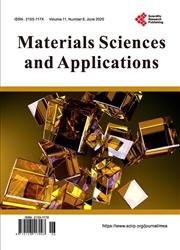Incorporation of Nano-Zinc Oxide in Lamellar Zirconium Phosphate: Synthesis and Characterization
引用次数: 0
Abstract
In order to provide ultraviolet barrier, antifungal and antibacterial properties, nano-zinc oxide (ZnO) was added to lamellar zirconium phosphate (ZrP). The phosphate was synthesized via reaction of zirconium oxychloride octa-hydrate and phosphoric acid following its chemical modification with Jeffa-mine and nano-ZnO. Diffractometric, morphological, thermal, structural and relaxometric evaluations were conducted. Fourier transform infrared spectroscopy (FTIR) revealed increase of the area between 4000 - 3000 cm −1 due to the formation of ionic specie PO − + NH 3 -[C-(H)(CH 3 )-CH 2 -O-(C-(H)(CH 3 )- CH 2 -O) 8 -(CH 2 -CH 2 -O-CH 3 )] and nano-ZnO particles. Wide-angle X-ray diffraction indicated that intercalation of Jeffamine was successful. Thermogra-vimetry confirmed that nano-ZnO particle forced the expulsion of Jeffamine outside ZrP galleries. Scanning electron microscopy evidenced the Jeffamine intercalation and sample heterogeneity. Hydrogen molecular relaxation indicated the increase of molecular rigidity owing to the formation of ionic specie and the addition of nano-ZnO particles. It was postulated that a multifunctional and miscellaneous material constituted by as prepared ZrP, some de-laminated ZrP platelets and nano-ZnO particles was achieved. The material has potential for usage as filler in polymeric composites.纳米氧化锌在层状磷酸锆中的掺入:合成与表征
将纳米氧化锌(ZnO)添加到层状磷酸锆(ZrP)中,以提高其抗紫外线、抗真菌和抗菌性能。以八水合氯化氧锆为原料,经杰华矿和纳米氧化锌的化学修饰后,与磷酸反应合成了该磷酸盐。进行了衍射、形态、热、结构和弛豫评价。傅里叶变换红外光谱(FTIR)显示,由于PO−+ nh3 -[C-(H)(CH 3)-CH 2 - o- (C-(H)(CH 3)-CH 2 - o) 8 -(CH 2 -CH 2 - o- CH 3)]和纳米zno粒子的形成,面积在4000 ~ 3000 cm−1之间增加。广角x射线衍射表明,Jeffamine的插层是成功的。热失重法证实,纳米氧化锌颗粒迫使Jeffamine在ZrP通道外被排出。扫描电镜证实了Jeffamine的嵌入和样品的非均质性。氢分子弛豫表明,由于离子种的形成和纳米zno粒子的加入,分子刚度增加。假设制备的ZrP、去层合ZrP薄片和纳米zno颗粒组成了一种多功能杂化材料。该材料具有作为高分子复合材料填料的潜力。
本文章由计算机程序翻译,如有差异,请以英文原文为准。
求助全文
约1分钟内获得全文
求助全文

 求助内容:
求助内容: 应助结果提醒方式:
应助结果提醒方式:


